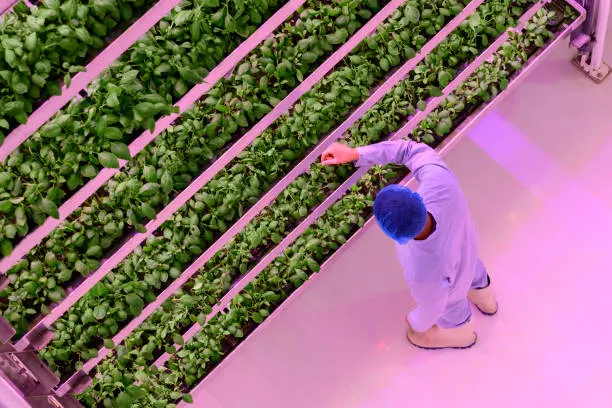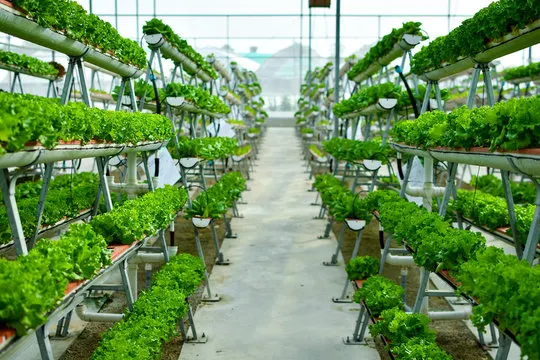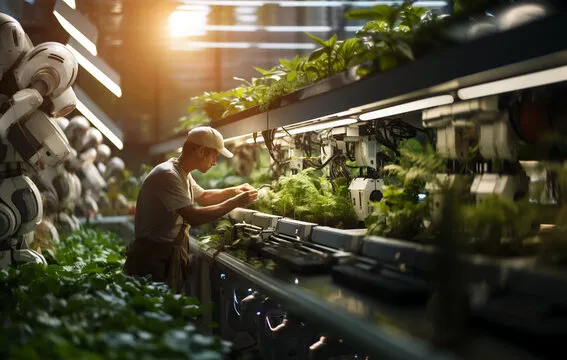The Growing Need for Urban Food Solutions
As cities continue to expand, feeding a growing population has become a major challenge. Traditional farming requires vast amounts of land, water, and resources, which are often scarce in urban areas. To address this issue, vertical farming has emerged as a revolutionary solution. By growing crops in stacked layers inside buildings, this method maximizes food production while minimizing land use. But is vertical farming the future of urban food production? Let’s explore its potential, benefits, challenges, and future scope.
What is Vertical Farming?
Vertical farming is an indoor agricultural technique that involves growing crops in vertically stacked layers, using controlled-environment agriculture (CEA) and technologies such as hydroponics, aeroponics, and aquaponics. These farms are typically housed in warehouses, skyscrapers, or even shipping containers.

Key Technologies Used:
- Hydroponics – Growing plants in nutrient-rich water without soil.
- Aeroponics – Spraying plant roots with nutrient-rich mist.
- Aquaponics – Combining fish farming with plant growth, where fish waste provides nutrients for plants.
- LED Lighting – Artificial lighting that mimics sunlight for plant growth.
- Climate Control – Automated systems that regulate temperature, humidity, and CO₂ levels.
Benefits of Vertical Farming
Vertical farming offers several advantages over traditional agriculture, making it an attractive option for urban food production.
1. Maximizes Space Utilization
- Uses less land by growing crops in stacked layers.
- Can be implemented in rooftops, basements, or unused urban spaces.
- Ideal for high-density cities where land is expensive and limited.
2. Reduces Water Usage
- Uses up to 95% less water than traditional farming.
- Recirculating water systems prevent wastage.
- Helps conserve water in areas facing drought or water shortages.
3. Eliminates Seasonal Dependency
- Crops can be grown year-round under controlled conditions.
- No reliance on weather conditions or soil fertility.
- Reduces crop failures caused by climate change or extreme weather.
4. Decreases Transportation Costs & Carbon Footprint
- Grown closer to consumers, reducing the need for long-distance transportation.
- Lowers greenhouse gas emissions from food supply chains.
- Ensures fresher and more nutritious produce reaches consumers faster.
5. Minimizes Pesticide & Chemical Use
- Controlled environments prevent pests and diseases.
- Eliminates the need for harmful pesticides and herbicides.
- Provides safer and healthier food for consumers.
6. Boosts Local Economies & Job Opportunities
- Encourages local food production and reduces import reliance.
- Creates jobs in urban farming, tech, and food industries.
- Supports sustainable business models and food security initiatives.

Challenges of Vertical Farming
Despite its numerous benefits, vertical farming faces some obstacles that must be overcome.
1. High Initial Costs
- Requires significant investment in technology, infrastructure, and energy.
- Setting up vertical farms can be expensive for small-scale farmers or startups.
2. Energy Consumption
- Relies heavily on artificial LED lighting and climate control systems.
- High electricity usage can increase operational costs.
- Requires a shift toward renewable energy sources for sustainability.
3. Limited Crop Variety
- Best suited for leafy greens, herbs, and small fruits.
- Difficult to grow large crops like wheat, rice, or corn.
- Researchers are working to expand the range of crops grown in vertical farms.
4. Technical Expertise Needed
- Requires knowledge of hydroponics, aeroponics, and automation systems.
- Farmers need training in managing controlled-environment agriculture.
- Not easily accessible to traditional farmers without technical support.
5. Market Acceptance & Consumer Awareness
- Some consumers may prefer traditionally grown produce.
- Educating people about the benefits of vertical farming is crucial.
- Price competitiveness with traditional farming is a challenge.

Case Studies: Successful Vertical Farming Projects
Several companies and initiatives have already proven the success of vertical farming in urban food production.
1. AeroFarms (USA)
- One of the largest indoor vertical farms in the world.
- Uses aeroponic technology to grow leafy greens in a controlled environment.
- Reduces water usage by 95% compared to traditional farms.
2. Infarm (Germany)
- A network of in-store vertical farms in supermarkets.
- Provides consumers with fresh produce grown on-site.
- Expanding across Europe and North America.
3. Sky Greens (Singapore)
- The world’s first commercial vertical farm.
- Uses rotating towers to grow vegetables efficiently.
- Helps Singapore increase food self-sufficiency.
4. Plenty (USA)
- A high-tech vertical farming company backed by major investors.
- Focuses on maximizing efficiency and sustainability.
- Uses AI and robotics for smart farming.
The Future of Vertical Farming
Vertical farming is expected to grow rapidly in the coming years due to advancements in technology and increasing demand for sustainable urban agriculture.
1. Integration with Smart Cities
- Future cities will incorporate vertical farms into urban planning.
- Rooftop and building-integrated farms will become common.
- Smart farming technologies like AI and IoT will optimize production.
2. Expansion to More Crops
- Research aims to expand crop variety beyond leafy greens.
- Scientists are exploring methods to grow grains, tubers, and fruits indoors.
- Innovations in genetics and biotechnology will play a key role.
3. Collaboration with Retailers & Restaurants
- More grocery stores and restaurants will adopt on-site vertical farms.
- Consumers will have access to freshly harvested produce.
- Farm-to-table dining experiences will become more common.
4. Sustainable Energy Solutions
- Adoption of solar, wind, and geothermal energy to reduce electricity costs.
- Improved energy-efficient LED lighting and climate control systems.
5. Government & Policy Support
- Governments worldwide are encouraging urban farming through incentives and grants.
- Policy changes to support vertical farming in cities.
- Increased investment in research and development.
Conclusion: Is Vertical Farming the Future?
With its ability to produce food efficiently in urban areas, vertical farming is a game-changer in modern agriculture. While challenges like energy consumption and high costs remain, continued technological advancements and increased awareness can help overcome these obstacles. As more cities adopt sustainable and smart farming solutions, vertical farming is set to reshape the way we grow and consume food, making it a key player in ensuring future food security.
Do you think vertical farming is the solution to urban food challenges? Let us know your thoughts!
The Future of Smart Homes and Home Automation: What’s Coming Next?





